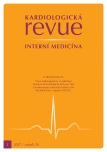Diuretics and mineralocorticoid receptor antagonists in the therapy of chronic heart failure with reduced left ventricular ejection fraction
Authors:
G. Mairgani 1; F. Málek 2
Authors place of work:
Odděleni Interna I, Nemocnice Teplice, Krajská zdravotní, a. s.
1; Kardiocentrum, Nemocnice Na Homolce, Praha
2
Published in the journal:
Kardiol Rev Int Med 2017, 19(1): 51-54
Summary
Diuretics are among the oldest drugs for the therapy of heart failure. The main role of diuretics is to reduce the signs and symptoms of systemic and pulmonary congestion. Loop diuretics are most frequently used for the therapy of heart failure because of their stronger diuretic effect. Some patients require a combination of loop and thiazide diuretics. The diuretic effect of mineralocorticoid receptor antagonists is weak; their role is to block consequences of secondary hyperaldosteronism, which occurs typically in the advanced stages of heart failure. We have evidence that spironolactone and eplerenone reduce mortality and morbidity in heart failure and thus modify the course of the disease.
Keywords:
heart failure – diuretics – mineralocorticoid receptor antagonists
Zdroje
1. Špinar J, Hradec J, Špinarová L et al. Souhrn Doporučených postupů ESC pro diagnostiku a léčbu akutního a chronického srdečního selhání z roku 2016. Cor Vasa 2016; 58(5): e530–e568.
2. Faris R, Flather MD, Purcell H et al. Diuretics fort heart failure. Cochrane Database Sys Rev 2006; 1: CD003838.
3. Faris R, Flather MD, Purcell H et al. Current evidence supporting the role of diuretik in heart failure: a metaanalysis of randomised controlled trials. Int J Cardiol 2002; 82(2): 149–158.
4. Volz EM, Felker GM. How to use diuretics in heart failure. Curr Treat Options Cardiovasc Med 2009; 11(6): 426–432.
5. Pitt B, Zannad F, Remme WJ et al. The effect of spironolactone on morbidity and mortality in patients with severe heart silure. N Engl J Med 1999; 341(10): 709–717.
6. Zannad F, McMurray JJ, Krum H et al. Eplerenone in patients with systolic heart failure and mild symptoms. N Engl J Med 2011; 364(1): 11–21. doi: 10.1056/ NEJMoa1009492.
7. Farquharson CA, Struthers AD. Increasing plasma potassium with amiloride shortens the QT interval and reduces ventricular extrasystoles but does not change endothelial function or heart rate variability in chronic heart failure. Heart 2002; 88(5): 475–480.
8. Cheitlin MD, Byrd R, Benowitz N et al. Amiloride improves hemodynamics in patients with chronic congestive heart failure treated with chronic digoxin and diuretics. Cardiovasc Drugs Ther 1991; 5(4): 719–725.
9. Málek F, Špaček R. Blokáda receptoru aldosteronu v terapii chronického srdečního selhání. Cor Vasa 2002; 44(1): 32–36.
10. Pitt B, Remme W, Zannad F et al. Eplerenone, a selective aldosteron blocker, in patients with left ventricular dysfunction after myocardial infarction. N Engl J Med 2003; 348(14): 1309–1321.
Štítky
Dětská kardiologie Interní lékařství Kardiochirurgie KardiologieČlánek vyšel v časopise
Kardiologická revue – Interní medicína

2017 Číslo 1
- Není statin jako statin aneb praktický přehled rozdílů jednotlivých molekul
- Tirzepatid – nová éra v léčbě nadváhy a obezity
- Antikoagulační léčba u pacientů před operačními výkony
Nejčtenější v tomto čísle
- Diuretika a antagonisté mineralokortikoidních receptorů v terapii chronického srdečního selhání se sníženou ejekční frakcí levé komory
- COSYREL – lék pro pacienty s ischemickou chorobou srdeční a srdečním selháním
- Rivaroxaban – farmakologický profil
- Pozdní následky kardiotoxicity

